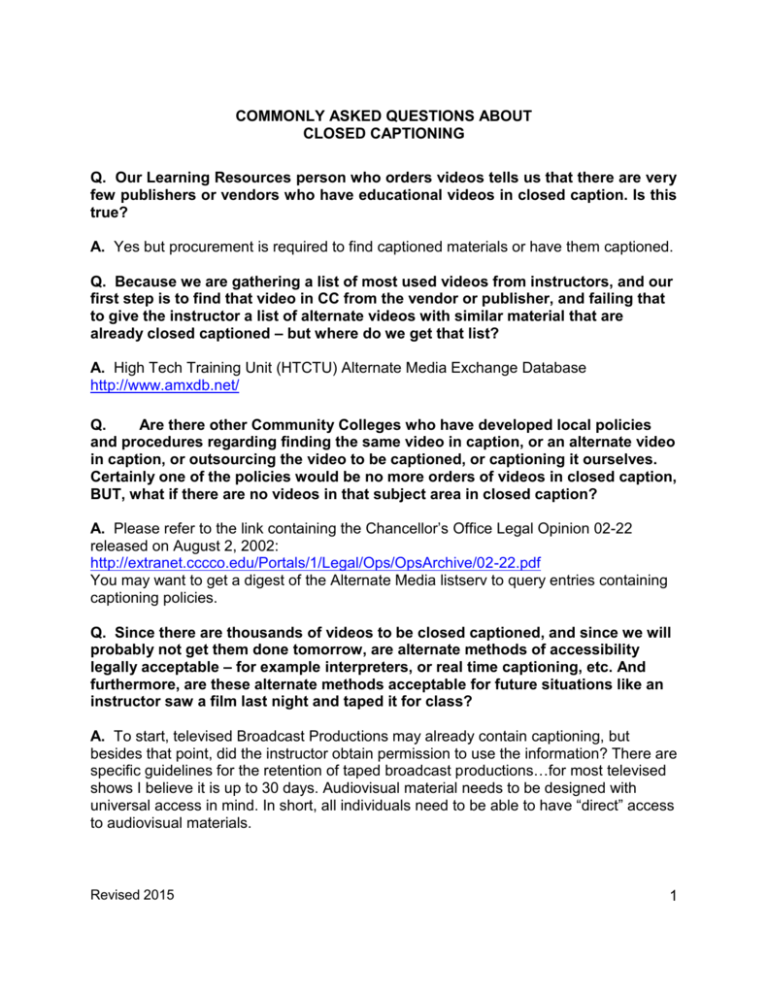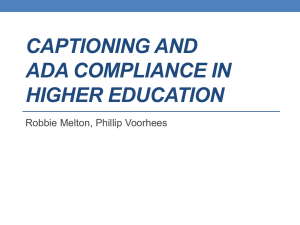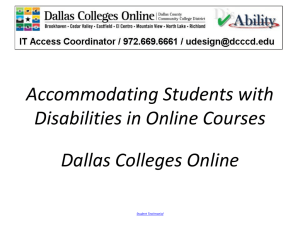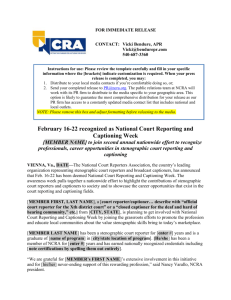FAQ Closed Captioning - Interwork Institute DSPS Solutions
advertisement

COMMONLY ASKED QUESTIONS ABOUT CLOSED CAPTIONING Q. Our Learning Resources person who orders videos tells us that there are very few publishers or vendors who have educational videos in closed caption. Is this true? A. Yes but procurement is required to find captioned materials or have them captioned. Q. Because we are gathering a list of most used videos from instructors, and our first step is to find that video in CC from the vendor or publisher, and failing that to give the instructor a list of alternate videos with similar material that are already closed captioned – but where do we get that list? A. High Tech Training Unit (HTCTU) Alternate Media Exchange Database http://www.amxdb.net/ Q. Are there other Community Colleges who have developed local policies and procedures regarding finding the same video in caption, or an alternate video in caption, or outsourcing the video to be captioned, or captioning it ourselves. Certainly one of the policies would be no more orders of videos in closed caption, BUT, what if there are no videos in that subject area in closed caption? A. Please refer to the link containing the Chancellor’s Office Legal Opinion 02-22 released on August 2, 2002: http://extranet.cccco.edu/Portals/1/Legal/Ops/OpsArchive/02-22.pdf You may want to get a digest of the Alternate Media listserv to query entries containing captioning policies. Q. Since there are thousands of videos to be closed captioned, and since we will probably not get them done tomorrow, are alternate methods of accessibility legally acceptable – for example interpreters, or real time captioning, etc. And furthermore, are these alternate methods acceptable for future situations like an instructor saw a film last night and taped it for class? A. To start, televised Broadcast Productions may already contain captioning, but besides that point, did the instructor obtain permission to use the information? There are specific guidelines for the retention of taped broadcast productions…for most televised shows I believe it is up to 30 days. Audiovisual material needs to be designed with universal access in mind. In short, all individuals need to be able to have “direct” access to audiovisual materials. Revised 2015 1 Q. I call a vendor to order a video. I request that it be closed captioned. Vendor says that they do not have to close caption their videos and so I can only get a regular video. What are my options? Are vendors required to supply videos that are closed captioned? A. Please review the Federal Communications Commission (FCC) Report on Captioning which can be accessed by “clicking” on the link that is provided below. https://www.fcc.gov/encyclopedia/closed-captioning-video-programming-television If the material that you are requesting does NOT fall within one of the broadcast categories outlined in the FCC Report, then the producer/distributor/manufacturer of the audiovisual work is NOT mandated to supply the video in closed captioning format. Of course, it would serve both the vendor and consumer if the vendor would provide a captioned-version. This would be an effective marketing strategy for the vendor, particularly if the material is widely used by public postsecondary educational institutions which are required to provide equal and effective access to educational programs and services to individuals with disabilities; and material which would provide greater access to individuals whose first (primary) language is not English. If the vendor does not have the audiovisual work in captioned format, then your options are (1) to request that the vendor supply one to your college (at no additional expense, preferably) with closed-captioning, (2) elect NOT to purchase the video from that particular vendor, (3) obtain the authorization from the vendor to alter/distribute a captioned version of the work for educational purposes, (4) to obtain legal counsel to review the National Captioning Institute (NCI) opinion and determine if copyright authorization is necessary, or if the modification of the audiovisual material falls within the “Fair Use Provision” of the U.S. Copyright Law, or (5) determine another method to ensure the accessibility of the audiovisual work to individuals with disabilities. The high Tech Center Training Unit has captioning resources at this address: http://www.htctu.fhda.edu/about/outside_resources.htm In addition funding for captioning is available through the Distance Education Captioning and Transcription grant, hosted by College of the Canyons. Projects eligible for funding include instructional materials used in online and hybrid classes. For more information, please see: http://www.canyons.edu/Offices/Distance_Learning/Captioning/ Q. Can DSPS funds be used to caption a new video when a captioned video is not available? A. Beginning in the State fiscal year 2000-01 and continuing for the next five fiscal years, each community college received DSPS funds to caption video-based instruction. In addition, each college received a one-time allocation in the State fiscal year 2000-01 to purchase captioning equipment. It is, therefore, an appropriate DSPS expenditure to caption a new video when a captioned video is not available. Revised 2015 2 Q. Can we buy a captioned version of a video that the college already owns if it is still available? A. Yes! However, before you select any instructional (or resource material) you should consult with relevant campus Faculty and Staff. Q. Can we buy a new video that covers the same material and is captioned if the older edition of the video is not available in captioned format? We have found some quite inexpensive videos in the sciences that cover the same material we needed to replace in captioned format. This would cost much less to make the material accessible. A. You need to meet with both Faculty and the Librarian to coordinate the selection (or substitution) of instructional (or resource) materials. Do not attempt to “decide” if an audiovisual work is a “cost-effective, reasonable alternative” without consulting those individuals on campus that are responsible for using (or storing) instructional media. If the vendor does not have the audiovisual work in captioned format, then your options are (1) to request that the vendor supply one to your college (at no additional expense, preferably) with closed-captioning, (2) elect NOT to purchase the video from that particular vendor unless they agree to provide audiovisual material with captioning, (3) obtain the authorization from the owner of the original audiovisual work to alter/distribute a captioned version of the work for educational purposes, (5) determine another method to ensure the accessibility of the audiovisual work to individuals with disabilities (e.g. transcript, real-time captioning, interpreter). If the vendor does have the audio visual work in captioned format (and critical college faculty and staff have decided to retain the material), then I would recommend that you purchase the video with captioning. Q. We are currently in partnership with CMAP (Community Media Access Partnership) which is paid for by Charter Communications Cable Company. They are housed on our campus and the program really is in its infancy. There will be four channels and one of those channels will be a College channel. Is captioning of the programs that go out on this channel a DSPS cost or is it an institutional cost? A. It is an institutional cost. If ANY of the funding is from the State, the requirements are that the programming will contain “direct access” and a “universal design” that is accessible to individuals with disabilities, and this includes captioning. We recommend you become familiar with the regulations governing media broadcasts. The media center specialists on your campus should be knowledgeable about the Telecommunications Act of 1996 and the requirements of the Federal Communications Commission. Here is a link that provides some information: Revised 2015 3 http://www.ntia.doc.gov/opadhome/opad_act.htm Q. If CMAP provides programming 24/7, do we really have to caption everything? A. Yes, most likely you do. Please refer to the Federal Communications Commission requirements related to captioning. Q. What about live TV shows? A. The College of the Canyons was awarded a Distance Education Captioning and Transcription grant to reimburse costs associated with college’s delivery of eligible “live distance education courses.” Please see: http://www.canyons.edu/Offices/Distance_Learning/Captioning/ Otherwise, please refer to the Federal Communications Commission requirements related to captioning. Q. In addition, does CMAP have the responsibility to caption the Public Access channel, the government channel, etc.? A. Yes. Please refer to the Federal Communications Commission requirements related to captioning. Q. Regarding Foreign Language Films - if the whole point of the video is to teach pronouncing skills by listening to the accent then captioning would not necessarily convey what the video is trying to teach. So by law do we have to caption it? A. INSTRUCTIONAL audiovisual materials (videos) in foreign language courses must provide equal access (captioning) for students with disabilities. It is more likely that audiotapes in foreign language labs would have a more narrow instructional focus (simply pronunciation) than you would expect from audiovisual material. The audio component of audiovisual materials provides greater depth or insight into the application and use of language. In the case of a foreign language film there would be other sounds (besides simply pronunciation), or visual cues, that would be captured in text intended to add to the understanding of the setting or context. That is, of course, unless the audiovisual material is simply an individual sitting in a chair speaking a foreign language; which, of course, is highly unlikely. A California Community College is a public institution that is REQUIRED to provide equal access to individuals with disabilities. This “requirement” is guaranteed to individuals with disabilities under the Rehabilitation Act of 1973, Section 504…”No otherwise qualified individual with handicaps in the United States…shall be excluded from the participation in, be denied the benefits of, or be subjected to discrimination under any program or activity receiving Federal financial assistance or under any program or activity conducted by a public entity.” Revised 2015 4 The Chancellor’s Office, California Community Colleges secured funding on behalf of all the community colleges to offset the costs associated with ensuring the accessibility of audiovisual materials. The special funding authorized by the State Department of Finance, and approved by the Governor, was part of a voluntary resolution measure the Chancellor’s Office, California Community Colleges arranged with the U.S. Department of Education, Office for civil Rights (OCR). Final note: If the deaf/hard of hearing student requires additional educational accommodations to ensure his/her academic success with the pronunciation of specific vocabulary words in the foreign language course; then, other strategies need to be deployed in addition to the captioning of the audiovisual material. Per CO Chief legal Counsel, “There is a provision in the Ed Code saying that English is the primary language of instruction, so we generally aren’t obligated to provide instruction or instructional materials in other languages.” However, if the course is a foreign language course, then we must provide equal access to the foreign language material for students with disabilities requiring an educational accommodation. Someone who cannot hear who is taking a foreign language will obviously have a different experience from the hearing students. That fact does not change the deaf or hard-of-hearing person’s need for access. If the hearing students are expected to use the video and a deaf student is in the class, the video will only be fully accessible if captioned. Q. Captioning foreign language videos – i.e. caption French tapes in French? French Tapes captioned in English…would having English captioning affect the integrity of the class? A. There is a difference between captioning and subtitles. “Captioning” is word for word/sound for sound transcription of text that appears on line 21 of the audiovisual material. “Subtitles” represent the translation of the language (e.g. French) into text format (e.g. English) that appears on line 21 of the audiovisual materials (subtitles normally do not include a text description of sounds). A student that is deaf/hard-ofhearing should be afforded the opportunity to view the text equivalent of the foreign language spoken in the instructional material; as well as benefit for the audible sounds in the video that are present to convey meaning. The captioning on foreign instructional material must reflect the actual spoken language contained in the film. So, for example, a French instructional tape must be captioned in the French language. Q. Is the intent of the law that we caption in the foreign language or language of the tape? A. Yes. Access to the information (in this case French) must be provided in an alternate format in the foreign language of the original audiovisual instructional material. On May 2, 2002, Ralph Black, Chief Legal Counsel, stated that “There is a provision in the Ed Revised 2015 5 Code saying that English is the primary language of instruction, so we generally aren’t obligated to provide instruction or instructional materials in other languages.” However, if the course IS a Foreign Language course, then we must provide equal access to the foreign language material in alternate format for students with disabilities requiring an educational accommodation. I recommend you contact the resource provided below if you are in need of audiovisual materials captioned in French: Devin Brown, Account Executive, National Captioning Institute, 303 North Glenoaks Blvd., /Suite 200, Burbank, CA 91502, PH (818) 238-4203, FAX (818) 238-4266, dbrown@ncicap.org NCI can currently caption Spanish and French from their Burbank location, but over 40 languages from their language center in England. Q. I’m about to start captioning an elementary Algebra Series for a Telecourse. Does anyone know if there are a set of standards to follow for captioning math? Do you write the numbers numerically (52) or spell them out (fifty-two)? And what about the symbols (plus or +)? A. The Rapid Text Style Guide for Captioning contains the following suggestions: NUMBERS AND MATHEMATICAL SYMBOLS: “Numbers need to be shown as …zero, one, two, three, four, five six, seven, eight nine, 10, 11, 12, 13, 14, 15, 16, etc. Zero through nine is written out, 10 and above are represented as numerals. The only exception is when the number is the first word in a sentence (unless it is an address). For example, I lived at 1345 Fourth Street, for five years; 1345 Fourth Street is where I lived for five years. My father just turned 62 years old; My son is turning three next month. I paid $25 for my new purse. If it is an even dollar amount, do not use the decimal unless cents are spoken.” Spell out the text equivalent for mathematical symbols. For example, use “plus” for +, and “minus” for -. For more information please contact the following resources for technical assistance: Teleperformance RapidText Formerly Aegis RapidText Kathy Furlan Kathy.Furlan@teleperformance.com Toll-Free: 800.234.0304 xt 47124 Revised 2015 6 NATIONAL CAPTIONING INSTITUTE Devin Brown Account Executive National Captioning Institute 303 North Glenoaks Blvd. /Suite 200 Burbank, CA 91502 PH (818) 238-4203 FAX (818) 238-4266 dbrown@ncicap.org Telestream at www.telestream.net 1-800-977-6678 WGBH-Captioning at access@wgbh.org or 617-300-3600 Q. What is the legal citation that allows students with qualified disability and accompanying educational limitation(s) to tape record class lectures? Our college has a part-time instructor who is an attorney and insists his lectures are copyrighted and absolutely will not allow this accommodation. I would like to provide him with the documentation to support our position. A. Both state and federal law/regulation provide the right to students with verified disabilities to record lectures or other classroom activity. Regulations for Section 504 of the Rehabilitation Act, CFR 34 104.44(b) says, “(b) Other rules. A recipient to which this subpart applies may not impose upon handicapped students other rules, such as the prohibition of tape recorders in classrooms or of dog guides in campus buildings, which have the effect of limiting the participation of handicapped students in the recipient's education program or activity.” State law, Education Code Section 78907, says “The use by any person, including a student, of any electronic listening or recording device in any classroom without the prior consent of the instructor is prohibited, except as necessary to provide reasonable auxiliary aids and academic adjustments to disabled students. Any person, other than a student, who willfully violates this section shall be guilty of a misdemeanor. Any student violating this section shall be subject to appropriate disciplinary action. This section shall not be construed as affecting the powers, rights, and liabilities arising from the use of electronic listening or recording devices as provided for by any other provision of law.” Revised 2015 7
![Community safeguards inquiry (2014) [DOCX 54 KB]](http://s3.studylib.net/store/data/006784762_1-337e9c809ec9a503c5cf314fa54c9244-300x300.png)




